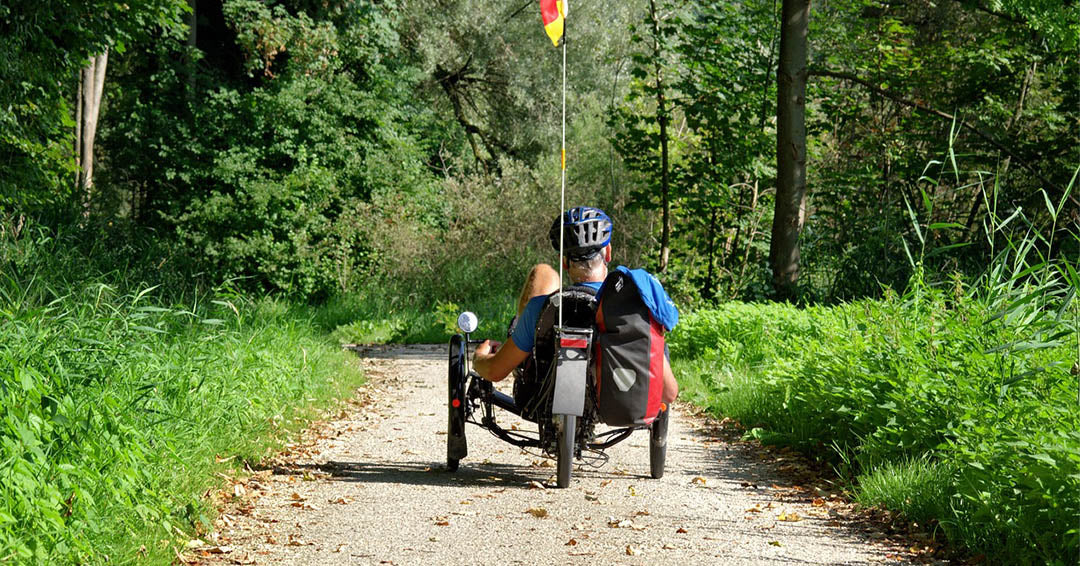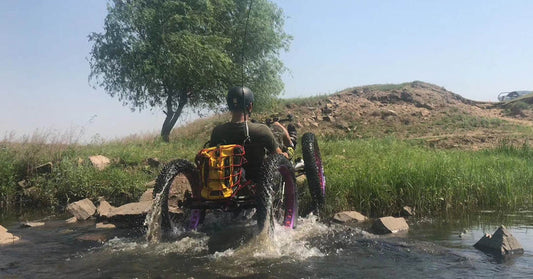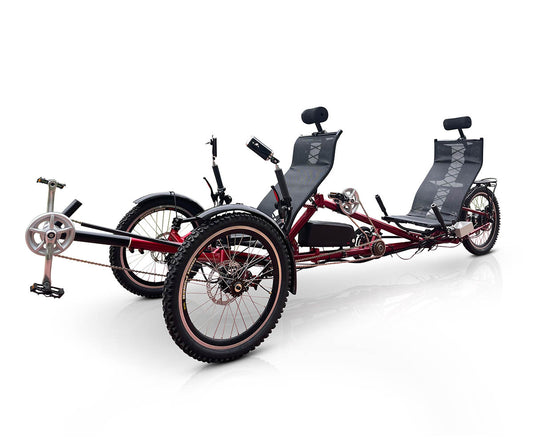
Versatile Journeys: Uncovering the Potential of Recumbent Trikes
Share
Welcome to the evolving world of recumbent trikes, where comfort, stability, and versatility meet to redefine cycling. Whether you’re a seasoned cyclist looking for a new challenge or someone seeking a comfortable alternative for commuting and recreation, recumbent trikes offer a compelling solution. Let's dive into what makes these three-wheeled vehicles a popular choice for a wide range of riders.
What is a Recumbent Tricycle?
A recumbent tricycle is a three wheeled vehicle, similar to a bicycle, in which the rider sits in a reclined seating position. This seating position allows for leverage to be applied against the seat while pedaling. The majority of recumbent tricycles are propelled by pedals designed for either the rider’s legs/feet or arms/hands. Recumbent tricycles (sometimes referred to as tadpoles, bent tricycles or trikes) are often favored by their users for their relative comfort and stability when compared to traditional bicycles.
A Brief History: The concept of the tricycle dates back to 1680, invented by German watchmaker Stephan Farffler, who was paraplegic. Farffler's creation was essentially a hand-powered tricycle, designed to provide mobility without the need for walking. This innovation predates the pedal-powered tricycle, which appeared in the late 1700s, and the modern bicycle, invented in 1817. Trikes grew in popularity throughout the 1800s, notably when Queen Victoria purchased a pair in the 1880s. Their appeal dwindled with the advent of the two-wheeled bicycle but has resurged recently thanks to their numerous advantages, particularly in cities with growing cycle-friendly infrastructure.
Fun Fact: The very first car, Benz Patent Motor Car, model no. 1. made in 1886 looks a lot like a delta configuration trike, with a vertical pivot axis for the front wheel and large wheels with spokes.
Standard Bikes vs. Recumbent Cycles: Contrasting sharply with standard upright bikes, recumbent trikes offer a laid-back riding position that many find more comfortable, especially on longer rides. This seating position alleviates stress on the back, neck, and shoulders, providing a supportive, low-stress riding experience. The aerodynamic posture also reduces wind resistance, making for an efficient ride. Recumbent trikes represent not just a different style of cycling, but a thoughtful reimagining of what cycling can be, combining ergonomic benefits with a touch of leisure and lots of practicality.
Types of Recumbent Trike
Recumbent trikes are designed to accommodate a variety of cycling needs and preferences, each model featuring unique configurations and specialties.
- Tadpole vs. Delta: The two primary configurations for recumbent trikes are tadpole and delta.
- Tadpole trikes have two wheels at the front and one at the rear. This design provides better front-end stability and is generally preferred for its handling, especially at higher speeds or on curved paths. The weight distribution in tadpole trikes helps in maintaining a low center of gravity, enhancing aerodynamics.
- Delta trikes feature one front wheel and two rear wheels. They offer easier access for mounting and dismounting, which can be beneficial for riders with mobility restrictions. Delta trikes tend to have a higher seat and a more upright seating position, which some riders find more comfortable and easier to adapt to from traditional bikes.
- Road vs. Fat Tire: The choice between road and fat tire trikes depends on the intended use. While the distinction refers to types of terrain, and the tires that best suit that terrain, just like traditional bicycles you will see differences in the frame and mechanics of recumbent trikes built for different purposes.
- Road trikes are equipped with narrower tires with shallow or no treads and are optimized for pavement and well-maintained paths, making them ideal for those looking to use their trike for exercise or commuting on city streets. They will often be built to be lighter and lower to the ground to reduce their aerodynamic profile, thus increasing their potential to attain higher speeds.
- Fat Tire Trikes (also known as off-road trikes): Built for adventure, these trikes feature wide, heavily treaded tires with lower air pressure for superior traction across diverse terrains such as sandy beaches and rocky trails. They often include full and adjustable suspension systems (as opposed to the more common rear suspension found on stock, road, and hybrid models) to handle rough surfaces and are designed with stability in mind, prioritizing a sturdy build to withstand the rigors of off-road cycling.
- Hybrid Trikes: Catering to riders who want to navigate both urban landscapes and moderate trails, hybrid trikes offer the best of both worlds. They combine moderately wide tires with some tread, adaptable frames, and a versatile mechanical setup that performs well across various terrains. This balance makes them a popular choice for riders looking for general-purpose trikes that deliver flexibility without the need for specialization.
- Features: Many recumbent trikes come with a range of customizable features to enhance comfort and performance, such as adjustable backrests, customizable gearing, and optional electric-assist motors. For an in-depth look at these options, check out our detailed guide on recumbent trike features.
Where Can You Use a Recumbent Trike?
Recumbent trikes blend seamlessly into most environments where traditional bikes are found, from city streets to rural pathways.
-
General Accessibility: Just like bicycles, recumbent trikes are typically allowed anywhere that bikes can go—bike lanes, roads, and bike trails. Their design makes them particularly visible (especially when aided with flags or other vertical visibility aids for extra height) and stable, which is an advantage in mixed-traffic situations.
-
Motorized Recumbent Trikes: For those with electric-assist trikes, it’s important to be aware of local regulations. Many states follow a three-class system for electric bikes, which is also applicable to electric trikes:
- Class 1: These are pedal-assist only, with no throttle, and assistance up to 20 mph.
- Class 2: Includes throttle-assisted power and also caps assistance at 20 mph.
- Class 3: Pedal-assist only, with no throttle, and assistance up to 28 mph.
- In 38 states, these classifications help determine where motorized trikes can be ridden, often influencing whether they can be used on paths and trails designated for non-motorized use.
-
Want to dig deeper into all things electric cycles? Check out this article
Understanding where you can ride your recumbent trike, especially if it is motorized, ensures that you can enjoy your trips without interruption and in compliance with local laws. Always check the latest state and local regulations to stay informed about the places where your trike is welcome.
Recumbent Trikes vs. Recumbent Quads
When considering recumbent trikes and quads, each offers unique advantages, tailored to various types of riders and uses. Understanding these differences can help you choose the right vehicle for your needs.
- Availability and Variety: Recumbent trikes are more commonly produced than quads, giving riders a wider range of models to choose from. This availability makes it easier for new riders to find a trike that fits their specific requirements in terms of size, features, and price.
- Stability: While trikes are inherently stable compared to two-wheeled bicycles, quads offer even greater stability thanks to their four-wheel layout. This makes quads a better option for those who prioritize safety and are perhaps more concerned about balance.
- Transportability: One significant advantage of recumbent trikes is that many models come with a folding feature, making them easier to transport and store. This is particularly beneficial if you need to carry your trike in a car to a riding location or store it in a small space at home. Quads, typically non-folding and bulkier, can pose challenges in these aspects.
- Weight and Cost: Recumbent trikes generally weigh less and cost less than their quad counterparts. The lighter weight makes trikes easier to handle, especially when lifting or maneuvering in tight spaces, and the lower cost makes them a more accessible option for many riders.
- Terrain Navigation: The three-wheel tracking of a trike can make it less adept at handling very rough terrains compared to a quad, which distributes the impact across a broader area. However, this is generally only a concern in more extreme off-road conditions.
- Storage Capacity: Although quads often provide more storage space, making them ideal for shopping trips or long tours where carrying capacity is crucial, many delta trikes also offer substantial storage options, albeit sometimes with trade-offs in terms of aerodynamics or weight distribution.
Use Cases for Recumbent Trikes / Benefits of Recumbent Trikes
Recumbent trikes are not just an alternative to quads but have distinct benefits that make them particularly well-suited for various activities:
- Ease of Transport: The lighter weight and often foldable nature of recumbent trikes make them ideal for cyclists who travel to cycling spots or need to store their trike in limited space. This mobility extends the range of adventures they can partake in, from city tours to trail rides.
- Cycling Comfort and Accessibility: Recumbent trikes provide a comfortable ride with a low center of gravity and ergonomic seating position. This reduces fatigue and strain, making it a great choice for longer rides or for cyclists with back and joint issues.
- Cost-Effectiveness: Being generally less expensive than quads, recumbent trikes offer an economical way to enjoy the benefits of recumbent cycling without a hefty investment, making them a popular choice among newcomers and seasoned cyclists alike.
- Versatility in Use: Whether it’s cruising on city streets, enjoying paved bike paths, or exploring gentle trails, recumbent trikes handle a variety of environments effectively. Their design allows for easy maneuvering and quick adaptation to different riding conditions.
Recumbent trikes combine the joy of cycling with enhanced comfort and stability, making them a versatile choice for both recreational riders and those using them as a primary mode of transportation. Whether you’re looking to improve your fitness, reduce commuting stress, or enjoy the great outdoors, a recumbent trike offers a reliable and enjoyable way to achieve your goals.
The Mechanics of Recumbent Trikes
Understanding the mechanics behind recumbent trikes can often enhance your appreciation of their design and functionality, and subsequently, of the riding experience itself. Here's a look at the key mechanical features that define these innovative cycles:
- Drive System: Recumbent trikes typically use a chain-driven system, similar to standard bicycles, but the layout is adapted to fit the recumbent design. The chain runs from the pedals along the frame to the rear wheel, powering the trike. In models with more than one rear wheel, a differential may be used to evenly distribute power to both wheels, enhancing traction and handling on turns.
- Frame Construction: The frame of a recumbent trike is designed to provide a low center of gravity while supporting a laid-back seating position. This structure not only contributes to the trike's stability but also reduces aerodynamic drag, making the trike more efficient at higher speeds. Frames are typically made from lightweight materials such as aluminum or carbon fiber, balancing strength and weight.
- Suspension Systems: Many recumbent trikes come equipped with sophisticated suspension systems that absorb bumps and irregularities in the road. This feature is crucial for maintaining comfort during rides, especially when traveling over uneven terrain. Suspension options can vary from simple spring systems to more complex hydraulic or air shock absorbers.
- Steering Mechanisms: Recumbent trikes typically feature either direct or indirect steering. Direct steering offers a tactile response and precise control, ideal for those who prefer a sporty ride. Indirect steering provides a smoother, more stable handling experience, suited for long-distance touring. Both types aim to enhance comfort and efficiency in different riding conditions.
These mechanical aspects ensure that recumbent trikes provide a stable, comfortable, and responsive ride, making them ideal for everything from leisurely jaunts to more demanding tours.
Embrace the Ride: Exploring Further
As we conclude our exploration of recumbent trikes, it's clear that these vehicles are more than just a means of transportation; they are a gateway to enhanced mobility and enriched lifestyle. The comfort, stability, and efficiency they offer make them an excellent choice for anyone looking to improve their cycling experience.
Whether you are new to the world of recumbent trikes or looking to deepen your understanding, there is much more to learn and explore. We invite you to dive deeper into our articles for more detailed reviews, user guides, and expert advice. And if you're ready to take the next step, browse our marketplace to discover the wide range of recumbent trikes available. Choose the perfect model that fits your lifestyle and start enjoying a smoother, more comfortable ride today.
Your journey on three wheels begins here—embrace it and ride towards a healthier, more joyful cycling experience.


